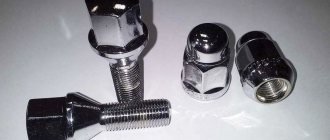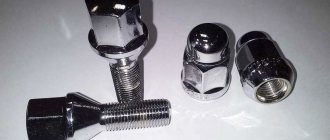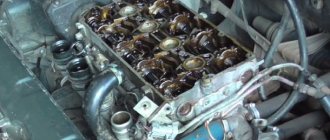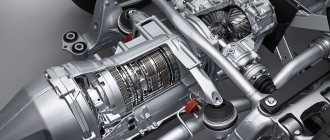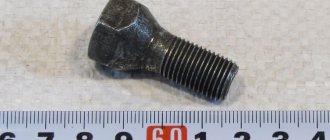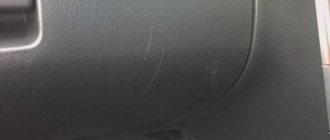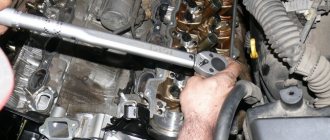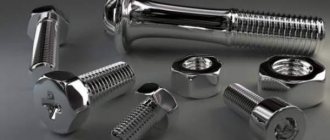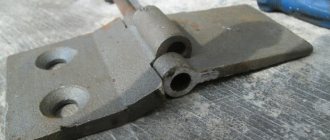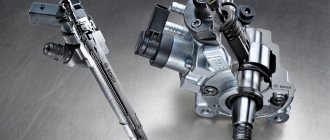What is a nut and bolt?
Let's start with the theory and remember what a nut and bolt are, as well as what functions they perform:
- A bolt is a rod made of metal and having a square or hexagonal head, as well as a thread intended for screwing on a nut. Today there are many types of bolts, the design and shape of which depends on the purpose. Here it is worth highlighting anchor, hinged or eye bolts, bolts with a countersunk or semicircular head.
- A nut is a fastening element that has a hole with a thread cut inside. As a rule, nuts are hexagonal in shape and can be unscrewed with a wrench. But there are other versions of products - round with a notch, with a protrusion and others.
Flush break
This type of failure is considered the most difficult to repair, since it is very difficult to determine the diameter of the hole, especially when cutting fasteners. Therefore, in order to drill out a broken bolt of a certain type, it is necessary to clean the surface. This will allow us to determine the gaps we need.
The following unpleasant situation often occurs: the breakage site has curved shapes that are very difficult to process and straighten. And it is categorically not recommended to drill a product in such a state, because there is a risk of completely ruining the structure. Therefore, you first need to use a core, which is used to prepare a place in the center of the drill.
The further procedure for drilling out a bolt that has broken in one way or another is similar to the option for a surface break. After creating the hole, the remaining threads are removed using a hook.
The problem of rusted bolts and nuts
It is important to remember that the fasteners in question are made of metal. This means that the bolt and nut are susceptible to corrosion.
Products used in cars are resistant to moisture, rain, fog or snow. All this can become a catalyst for the formation of rust and problems with twisting products.
No less difficult is created by sand, salt or chemical compounds that are sprinkled on the road surface in winter.
Special reagents have a negative effect on body metal and accelerate the formation of rust on the threaded elements of the car.
As for sand, it carries certain risks at any time of the year - winter and summer.
Small grains of sand hitting a metal surface leave microcracks on it, which only accelerates the corrosion process and complicates the maintenance process for the car owner.
Another risk factor is the vehicle’s cooling system, which may lose its seal during operation.
If water is flooded inside, if a leak occurs, it gets into the joints and accelerates the process of scale formation and problems with unscrewing.
No matter how the car owner protects the car, each of the listed factors has a negative impact.
That's why it's important to know how to unscrew a rusty nut or bolt without creating additional problems for yourself (for example, damaging adjacent and expensive parts of the vehicle).
Method No. 1: dissolving rust
How to unscrew a rusty nut? We will not suffer with the tool, wasting our strength in vain. Let's go in search of a substance that will help dissolve rust and reduce friction. Of the most famous ones that have proven themselves well:
- Special product WD-40.
- Kerosene.
- Brake fluid.
- Petrol.
- Carburetor cleaner.
- Alcohol.
- Table vinegar.
- Iodine.
- “Coca-Cola” and other drinks containing inorganic phosphoric acid.
We are sure that at least one of the above is at your fingertips. Next, the algorithm of your actions is simple:
Wet the nut well with
Wait about half an hour. After this, try to carefully unscrew the part with a tool. If it doesn’t work out, apply the substance again and wait. The product will work better if you soak a rag or napkin in it and wrap it around the nut. You can then speed up the unscrewing by lightly tapping the part with a hammer. Another effective way is to try to twist the nut with a strong and sharp jerk after exposure to the solution. For a small nut, the “rocking” method will help - back and forth.
What is strictly forbidden to do (use of force)?
The main mistake of many beginners is a thoughtless approach to twisting and the use of “force” methods.
Remember, in order to unscrew a stuck element, it is important to be patient and not rush. Solving the problem requires a consistent and measured approach.
Haste in resolving an issue can cause many problems.
Thus, car owners often rush to unscrew a rusty bolt and tear off its upper part.
The result is drilling out the broken product, which will take a lot more time.
In addition, the result of haste may be damage to nearby nodes with the key, which will lead to the need for additional investments.
Before starting work, draw up an action plan, and then begin to implement it.
If you work in a hurry, the total cost of time and money may be higher. Moreover, there are enough methods to quickly unscrew a rusted nut or bolt. We will talk about them below.
Unscrewing methods
There are three main methods for unscrewing a stuck nut:
- dissolving rust and dirt;
- heating the nut;
- mechanical damage to the nut.
Let's deal with each of them in turn.
How to dissolve rust
The essence of the technique is a chemical effect on rusty threads and, as a result, reducing the friction force when unscrewing. Vinegar, alcohol, iodine, kerosene or gasoline may be suitable for these purposes. But it is best to use a composition called WD-40, which is designed specifically for such purposes.
I will describe the methodology in detail:
- The nut is thoroughly moistened with the substance described above and allowed to stand for 15-20 minutes. Then they try to unscrew it. If this does not work, wrap it with a rag soaked in the composition used, or with a napkin. Again they wait for a while.
- Most likely, everything will work out, and success can be secured by hitting the nut with a hammer. Just don’t hit the bolt threads, otherwise you’ll make your task much more difficult. I recommend lengthening the wrench with a piece of pipe of a suitable diameter - the lever will be much stronger. It will be easier to move the nut out of place if you securely place the wrench on it and make a sharp jerk. Just don't pull clockwise!
- With a small thread diameter, it is very convenient to unscrew the nut by swinging, that is, working the wrench back and forth.
Heating process
Under the influence of high temperatures, metal tends to expand. As a result of such deformation, rust simply “looses its grip”, and the unscrewing process is greatly simplified. A hair dryer, a gas burner, a blowtorch - anything that produces a high heating temperature - can be used as a heating element. Don't be afraid - you are unlikely to be able to melt the metal from which the fasteners are made.
How exactly to proceed:
- Warm up the connection thoroughly, and then try to get the process off the ground using a spanner wrench.
- Sometimes it happens that the edges of the nut are licked off, then the wrench is useless. In such cases, a socket head is welded to it, the entire structure is heated, and then it is unscrewed using a wrench.
Mechanical impact
This method is resorted to if the previous two did not help or when there is no task to keep the connection intact. To work, you can use a hammer and chisel, a grinder or a hacksaw.
The essence of the technique is as follows:
- You can use a hacksaw or grinder to saw the nut along the axis of the bolt, and then removing it will not be difficult.
- There is another radical method - using a hammer and chisel. By driving it deeper, you can knock down the threads and increase the internal diameter of the nut. But this is completely, as they say, out of despair.
But the best way to combat souring of joints is to prevent it through timely application of lubricant. In this case, the service life of the fasteners will at least double.
Subscribe to our Social networks
Tools for removing rusted nuts and bolts
Using force is not the best method in dealing with “stuck” fasteners. Most often, you can cope in simpler ways - with the help of special means.
Here are the most popular options:
- WD-40 is a classic lubricant for car owners for all occasions.
- Flammable liquids - kerosene, turpentine, diesel fuel or gasoline. It is not always possible to unscrew a rusted bolt or nut using such compounds, but you should try.
- Acid. If you have a weak acid on hand, use it. The point is that the working fluid dissolves metal oxides.
- Coca Cola. If nothing is found from the above list, you can use the drink Coca-Cola, beloved by many. Its peculiarity is the presence of orthophosphoric acid in its composition, which effectively copes with oxidative processes.
Break on the surface
Usually this is the simplest type of breakdown and can be fixed without radical measures, which can sometimes harm your car or other unit. However, before unscrewing the broken bolt, you need to treat the breakage area with kerosene. This will help eliminate waste and reduce surface contact. Next you need to follow the following recommendations:
- If the protrusion is large enough, it is best to use simple tools such as clamps, pliers or pliers. With their help, it is easy to grab and turn the part along the thread without applying much effort;
- Some craftsmen, when answering the question of how to unscrew a broken bolt, advise using a welding unit. It will allow you to weld a lever to the hardware, which will help you unscrew or unscrew the connection by creating a rotational movement with the required pressure;
- There is also an option in which you can use a drill with a diameter slightly smaller than the bolt itself. A hole is made in the center of the bolt axis to the full depth. Then the remaining fasteners are removed using a hook, unscrewing the thread from the very bottom.
These are the most general recommendations; a combined use of these methods is possible. These breakdowns are the simplest, they require only minor processing and the use of simple tools.
Effective ways to unscrew a rusty bolt or nut?
If we consider more effective ways to combat rust, it is worth highlighting the following methods.
Heat
From the physics course we know that metal tends to expand as temperature increases. This feature can be used to solve the problem.
To unscrew a rusty nut, warm it up thoroughly, and then immediately try to unscrew it.
It is important to act quickly here so that the metal product does not have time to cool down. The essence of the manipulation is that due to uneven heating, the rust is deformed and has less restraining force.
Heating can be carried out in any available way. This could be a gas burner, a candle, a lighter, or even a soldering iron.
You can also use a blowtorch or other device.
When using this technique, be careful and remember the contraindications. In particular, heating is not recommended if wood or paintwork products are located in the joint area.
In this case, the part will be damaged and you will have to spend money on replacing it.
Tapping
You can unscrew a rusty nut or bolt using the traditional method - by tapping around the perimeter of the part.
Mechanical impact on each side allows for greater deformation, which contributes to the scattering of rust.
While tapping, be careful not to damage the edges of the nut. Otherwise, the task of twisting will become more difficult.
Spin
You can also go the other way. First, tighten the nut (bolt) with maximum force, and then try to rock the connection and dislodge the rust layer in this way.
If the manipulation is successful, unscrewing the nut or bolt will not be difficult.
Wax cup (difficult, not practical, but possible).
This technique cannot be called popular, but in terms of effectiveness it is in no way behind its “competitors”.
The algorithm of actions is simple. Make a cup-shaped shape from plasticine or wax so that its sides are above the level of the nut (about 2-3 mm).
Then dilute the sulfuric acid, pour the liquid into the prepared cup and add a little zinc. This chemical combination provides a galvanic effect and the ability to unscrew the part.
Destruction
If none of the above methods produces results, and the upper part is broken or severely deformed, there is another solution - breaking the bolt and drilling it out of the vehicle part.
Here, to complete the work you will need a hand or electric tool, as well as a set of drills of a suitable diameter.
Before drilling, place the drill bit in the center of the bolt and hit it with a hammer. This is necessary to deepen the product in the central part to a certain depth.
First, work in small increments and make sure that the drill enters exactly in the central part (tilts to the left and right are prohibited).
Start with a small diameter drill and then move on to a larger piece.
When choosing a drill, pay attention to two criteria - price and country of origin.
Please note that high quality products cannot be cheap, because they are made from hardened steel and sharpened in a certain way.
At the same time, special drills do an excellent job with aluminum, cast iron and other materials (including brittle ones).
To ensure correct drilling, use special lubricants, which can solve several problems at once - protect the drill from strong heat, cool the metal and lubricate the drilling elements. As a result, the whole process becomes easier.
Unscrewing methods
To unscrew stuck bolts, you can use several techniques and methods. You can perform these manipulations yourself at home. Before using this or that method, it is necessary to thoroughly clean the connection site from all contaminants and, during a visual inspection of the mounting site, try to determine the type of damage to the bolt. Depending on the type of damage, you can resort to mechanical, chemical or physical methods of unscrewing it.
Mechanical
Mechanical methods include all methods that involve the use of great physical effort when trying to break a damaged connection. The mechanical method can only be used if the bolt is not cracked, chipped or bent.
The mechanical method involves several nuances.
Using box wrenches instead of regular wrenches. Since a regular open-end wrench is capable of influencing only 3 edges of the head when unscrewing, as a result of strong impact these edges can be erased and the key will slide off. The spanner grips all 6 corners of the bolt, which will help you apply more force to unscrew it.
Using the extended handle of the key as a lever. Lengthening the handle of the wrench will help put more pressure on the bolt, and prevent rust from getting in the way.
Application of short-term force effects on different points of the rusted connection part. You will need a hammer and a chisel, with the help of which you first need to knock out a notch on the bolt head, and then hit it with force in the direction of unscrewing. This effect is more powerful than when unscrewing it with a wrench, and it will be possible to unscrew a stuck bolt much faster.
The impact of a force of alternating direction on a bolt. To unscrew a bolt using this method, you must first tighten it and then try to unscrew it. This manipulation can be repeated several times, since alternating movement in different directions will help free the threads from rust.
Destruction of the rust layer using impacts. It is necessary to strike those areas of the bolt that are most affected by corrosion. The applied force will help remove the rust, but damaged connection parts after such exposure will have to be replaced with new ones.
Physical
These methods for unscrewing rusted bolts are based on the physical properties of the materials used in the manufacture of connecting parts. There are the most common and frequently used methods.
Heating of connecting pair parts. To heat the parts, use any source of heat or fire: gas burner, blowtorch, soldering iron, hair dryer.
If you heat up the entire connecting structure, then under the influence of high temperatures the rust will begin to break down and fall off the connecting elements.
Applying liquid to threads. When penetrating into the micro-holes between the nut and bolt, liquids such as gasoline, kerosene, white spirit, and turpentine can reduce the friction between the stuck surfaces, which will ensure easier unscrewing. The same property is possessed by products called “liquid key”, which can be purchased at any auto store.
Chemical
The action of chemical methods is based on dissolving a layer of old rust using acids. Acids have properties that help destroy the corrosion layer:
- salt;
- sulfuric;
- lemon;
- orthophosphoric.
To dissolve the layer of rust on the connecting pair, the joint must be treated with a few drops of the reagent so that they can penetrate the micro-holes on the bolt thread. If a large area is affected by corrosion, then, if possible, the bolt can be soaked in acid.
The time required for exposure to the acid must be at least 24 hours. After it has expired, first tap the connection with a hammer so that large pieces of rust fall off, and then try to unscrew the nut with a wrench.
Following the recommendations given, it will be much easier to unscrew a stuck connection. If none of the above methods failed to remove the stuck bolt, you can resort to cutting it off with a grinder or drilling it. But before applying these measures, it is necessary to weigh all their positive and negative sides.
Other recommendations
To unscrew a rusty nut or bolt, it is enough to know how to unscrew products. We looked at the main options above, but there are a few more tips that may be useful in operation.
For example, to unscrew a bolt with torn edges, many recommend immediately cutting off the head.
Do not rush to resort to extreme measures (you will always have time for this).
Try the following options:
- Find a gas (adjustable) wrench and try to unscrew the rusted bolt with it.
- Take a hammer and chisel, then place the latter at an angle and hit in the direction of twisting. If the bolt (nut) has a small diameter, this method will not work.
- Use a grinder to make a cut on the head of the bolt, then try to unscrew it with a screwdriver.
- If the head falls off, use a pin driver (the main thing here is to have something to grab onto).
- If you have a wrench on hand, use it before the bolt breaks.
As an option, you can purchase a special ASTROhim thermal key. All that is required is to apply the composition to the part for a few seconds, then use a wrench to unscrew the rusted bolt or nut.
The peculiarity of the lubricant is to freeze the part and prevent further corrosion.
Safety precautions
You should not forget about basic safety rules in any case of car care, especially when unscrewing rusty nuts. According to statistics, it is as a result of this banal activity that people most often knock off their fingers and hand joints, especially if it is carried out in a hard-to-reach place. To avoid this, you need to:
- Be extremely attentive, controlling your every movement;
- Clearly predict the development of events and remove foreign objects in the direction in which the hand with a spanner or other tool used will move when unscrewing. Then, even if the key slips, the hand, by inertia, continues its movement, will not encounter any obstacle on its way, and then there will be no injury.
Prevention
Judging by the information given above, unscrewing a rusted bolt or nut is not difficult, but it takes a lot of time and effort.
It’s easier to prevent problems and take into account a number of recommendations. Below are just a few of them:
- Coat the nuts that hold the muffler with an anti-corrosion compound before tightening. After this, treat the product with grease (for greater effectiveness, add a little graphite to the composition). This prevents sticking.
- Wash the engine and the car as a whole from time to time. Dust and dirt that accumulate on the surface accelerate the process of corrosion.
- Buy only high-quality fasteners made of durable metal. When choosing, pay attention to such a criterion as strength class. Try not to skimp on nuts and bolts, because using cheap products leads to a number of problems in the future. At the same time, the question of how to unscrew a rusty fastener can become very relevant. Remember that we are talking about reliability and durability, savings on which are inappropriate.
- Do not abandon your car in a nearby or open parking lot. Storing a vehicle in a closed garage is an opportunity to reduce the risk of corrosion on connections. The negative impact of rain or cold negatively affects the condition of the body, as well as the vehicle’s fastenings.
- When performing work, use only high-quality tools - gas or ring wrenches, as well as special heads. Of course, this will require more money to purchase, but it is more convenient to use such a tool, and the mounts themselves last longer. A good tool allows you to solve two problems - maintain the integrity of the nut and protect it from damage, and also stretch the fastener with the required torque.
Using the extractor
However, the surest option to help unscrew a broken bolt is to use a special tool for this operation. It is called an extractor and is sold in a set of tools of different diameters . Outwardly, it is similar to a tap, but it does not have longitudinal slots and has a conical notch for cutting.
You can use the extractor after drilling a hole in the center with a diameter that will allow the tool to go several turns. Turn it until it stops, and then until it is completely unscrewed.
So, here are some ways to remove broken bolted parts. Each of them should be used depending on the complexity of the breakdown and the availability of appropriate tools. But the most practical and optimal option is to purchase a set of extractors. They are quite practical and allow you to work with bolted parts of various sizes and with any types of threads.
When one door closes, 10 open
This is how a person works: when one door closes in front of him, he can no longer think about anything except that he has been defeated. He is filled with pain and resentment: “Well, how is this possible? After all, I gave so much strength and energy, and - again..."
In fact, we simply perceive such moments incorrectly. In fact, they are key to our Journey. First, you realize how much you want something. And secondly, you will learn a lesson from what happened, and next time everything will happen completely differently.
Remember that if you don’t get something, it’s only for one reason - life has prepared something much better. You just have to try and push a little more.
Why do you need an estimate?
An estimate is necessary to prevent unforeseen situations and to purchase the necessary elements before starting work. If a specialized company is involved in preparing the documentation, it will most likely recommend you a store where prices for materials are quite reasonable. A pre-compiled estimate will allow you to assess whether the initially allocated budget for repairs is sufficient, which means that work will not stop due to lack of finance. Knowing the prices for the necessary heating elements, you will not follow the lead of the team’s workers to increase the payment for repair services. Of course, a professionally drawn up estimate also requires investment, but dismantling will be carried out without delays and unnecessary expenses.
How to calculate the cost?
Repair companies have websites that have a price list for their services. Prices depend on the number of works, and some are measured in square meters. However, prices for work should not exceed the indicators specified in the FER. FER is the federal unit rate. Thus, laying heating pipes, which costs 350 rubles per meter, falls within the FER indicators. It is quite acceptable to paint pipes for 70 rubles/meter. Having studied the FER and dismantling of heating pipes, the estimate and work process will become clearer. You can easily replace the heating or dismantle it.
Application of specialized heads
To unscrew a bolted connection that cannot be easily removed, specially designed heads are used. The problem occurs when the threads are stripped or the edges of the head are worn.
These heads include the so-called SL and UPK heads. They are specially designed for unscrewing bolts that have “licked” edges or are torn off and spin. A distinctive feature is the increased contact area between the inside of the head and the surface of the cap.
The main condition for the use of such heads is the exact selection of the internal size of the head to the size of the broken bolt.
Characteristics of fasteners
The main parameters of anti-vandal fasteners are the type of slot and the material of manufacture. The first include:
- Security Torx is a budget option.
- Spanner Head – the presence of two holes.
- One-way - tightened with traditional tools, but it is not possible to unscrew such a bolt without using radical methods.
One of the main distinguishing points is the presence of anti-corrosion equipment. The bolts are made from high quality materials and have proven themselves to be the most reliable. They produce products based on the following alloys:
- A2 is a favorite option of European manufacturers; it refers to stainless steels.
- A4 - similar in quality to the previous version, but at the same time it is resistant to aggressive chemicals.
It is almost impossible to unscrew such anti-vandal bolts without special tools, so they are actively used in structures in which protection from attacks by intruders comes first. They exhibit high resistance to aqueous and acidic environments, which significantly expands their scope of application.
We use a conductor
You can greatly simplify the operation of drilling out broken studs. This is relevant for those who often repair engines. A simple conductor will help the master. The dimensions of the part are taken from real engines. On the conductor, which is a metal plate, the same holes are drilled in the same places as on the head, as well as on the commutator. Holes for bushings are also made in the jig. They will keep the part from moving on the block.
With the help of such devices, you can greatly facilitate the task and figure out how to unscrew a broken pin from the exhaust manifold by drilling without damaging the manifold itself.
Read also: Cushions for car lifts
What was the discovery?
Dunning and Kruger determined that the most dangerous situation is when people have only superficial knowledge of a subject. This idea has been familiar to humanity for several generations in a row. So, back in 1709, Alexander Pope wrote the following phrase in his book “An Essay on Criticism”: “Half-knowledge is a dangerous thing.”
Or, as comedian Josh Billings puts it, “Your problems aren't because you don't know, but because you know for sure, but your knowledge is wrong.”
Unfortunately, there is no simple solution here. According to Dunning, for a bad employee to realize his incompetence, he will need the very expertise that he does not have.
Dunning and Krueger showed that as a person's knowledge of a particular subject increases or new skills are acquired, he begins to evaluate his own abilities less flatteringly. You realize everything that you still don’t know about this subject. And this is a completely different type of cognitive distortion - impostor syndrome.
